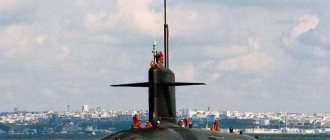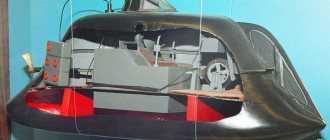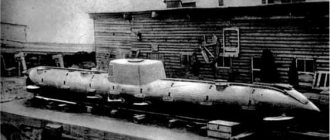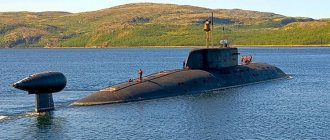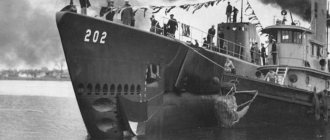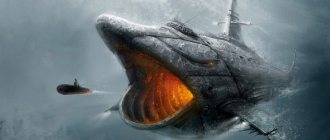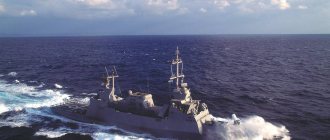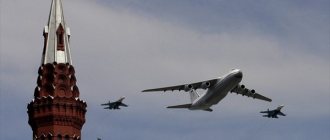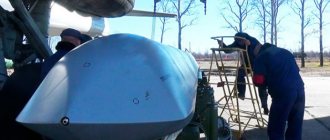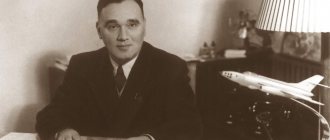"Astyut"
A British submarine using a pressurized water nuclear reactor that can operate for 25 years. Anti-acoustic plates are installed on the body, absorbing the locator signal. Can operate in shallow water to engage targets on land. A system for obtaining oxygen from sea water is provided.
Submarines are in service with the navies of many countries. They can track the enemy, engage in combat with him, fire long-range missiles, including nuclear warheads, and perform other strategic purposes during exercises and combat operations.
Submarine vs. Airplane: Duel in the Atlantic
More than a third of all losses of the Third Reich's submarine fleet in World War II were due to air attacks. When enemy aircraft appeared, the boat had to urgently dive and wait out the danger at depth. If there was no time left to dive, the submarine was forced to take on a battle, the outcome of which, however, was not always predetermined. An example is the incident in the Atlantic on January 6, 1944, when, northeast of the Azores, the submarine U 270 was attacked by a very unusual submarine hunter.
The struggle of two elements
During World War II, anti-submarine aircraft became the most dangerous enemy for German submarines. According to the famous German historian Axel Niestlé, during the “Battle of the Atlantic”, out of 717 combat German submarines lost at sea, the Allied anti-aircraft aviation accounted for 245 sunk submarines. It is believed that 205 of them were destroyed by shore-based aircraft, and the remaining 40 were attributed to carrier-based aircraft. Death from air strikes ranks first on the list of causes of losses for the German submarine fleet, while PLO ships sank only 236 submarines. Another 42 submarines were sunk to the bottom through the joint efforts of ships and aircraft.
A common sight in the Atlantic during war is a submarine attacked by an aircraft. In the photo, U 118 is under fire from the Avengers from the aircraft carrier Bogue on June 12, 1943 - on this day the boat will be sunk by them
However, hunting German submarines from the air was not easy or safe, and the Allies lost more than 100 aircraft during the war in such attacks. The Germans, quickly realizing the threat of Allied air attacks, constantly improved the protection of their submarine ships, strengthening anti-aircraft artillery and installing detection and direction finding equipment for aircraft using radar.
Of course, the most reliable way for a submarine to survive a meeting with an aircraft was to evade combat. At the slightest threat of attack from the air, the boat had to immediately dive and wait out the danger at depth. If there was no time left to dive, the submarine was forced to take on a battle, the outcome of which, however, was not always predetermined. An example is the incident in the Atlantic on January 6, 1944, when, northeast of the Azores, the submarine U 270 was attacked by a very unusual submarine hunter.
Preparing the Fortress Mk.IIA bomber of the Royal Air Force Coastal Command for departure. Noteworthy is the memorable late version of camouflage, characteristic of Coastal Command aircraft - with camouflaged upper surfaces, the side and lower surfaces were painted white
In the summer of 1942, the British received 64 four-engine Boeing B-17s under Lend-Lease. Having had negative experience using the Flying Fortresses over Europe as a daylight bomber (20 early B-17Cs reached the UK back in 1941), they immediately assigned the new machines to RAF Coastal Command. It should be noted that in the UK, all American aircraft had their own designations, and by analogy with the B-17C, called Fortress Mk.I, the newly received 19 B-17F and 45 B-17E received the names Fortress Mk.II and Fortress Mk.IIA, respectively . In January 1944, both British Fortress squadrons, 206 and 220, were consolidated into 247 Coastal Air Group and were based at Lagens airfield on the island of Terceira in the Azores archipelago.
"Seven" vs. "Fortress"
After the disbandment of the German Borkum group (17 units) operating against allied convoys in the North Atlantic, three boats from its composition were to form one of the small groups called Borkum-1. It also included the above-mentioned U 270 of Oberleutnant zur See Paul-Friedrich Otto. The boats of the new group were supposed to take a position northwest of the Azores, but this particular area was within the operational area of the 247th Air Group.
Bombers from Coastal Command's 247th Air Group are scattered across an airfield in the Azores.
On the afternoon of January 6 at 14:47, the Fortress with tail code “U” (serial number FA705) of Flight Lieutenant Anthony James Pinhorn from the 206th Squadron took off to search for and destroy enemy submarines. The plane did not return to base. The last message from him came at 18:16, after which the crew no longer contacted us. What happened to him? Entries from the surviving combat log of U 270 can tell about this.
On the evening of January 6, at 19:05, an airplane was spotted from a boat on the surface at a distance of 7,000 meters; the Vantse and Naxos electronic intelligence stations did not warn of its approach. The alarm was declared and anti-aircraft guns were prepared for battle. A few minutes later, the plane passed over the boat from the stern, but did not drop bombs, only firing at it from the tail turret. The shots from the “Fortress” did not harm U 270, which fired barrage from anti-aircraft guns. The plane repeated the approach, firing from machine guns, but again the bombs were not dropped. This time the aim was more accurate - the boat received several holes in the wheelhouse, its anti-aircraft gunners hesitated, and the plane avoided being hit.
U 270 crew officers on the bridge. In a white cap is the commander of the boat, Oberleutnant zur See Paul-Friedrich Otto. Visible on the horizon is an 85-meter-high monument to the memory of German sailors who died in the First World War, installed on the coast in Laboe (outskirts of Kiel)
Five minutes later, the “Fortress” attacked the “seven” for the third time from the stern. This time the “flaks” opened barrage fire in time, but the plane stubbornly walked straight towards the anti-aircraft guns. This was not in vain for him - the Germans managed to hit the right plane, and the engine closest to the fuselage caught fire. While passing over the boat, the plane dropped four depth charges set at shallow depth. The Seven made a sharp turn to port, and the bombs exploded approximately 30 meters from the bow of the boat. After a short period of time, the British plane, engulfed in flames, fell about 300 meters from U 270. The Germans did not find anyone at the crash site - the entire crew of the “Fortress” was killed. For this reason, the description of the battle exists only from the German side.
Recklessness vs recklessness?
The crew of the submarine acted harmoniously and courageously in a difficult situation; competent actions in controlling the boat and conducting anti-aircraft fire helped the Germans not only survive, but also destroy a dangerous enemy. However, despite the fact that the winners are not judged, it can be said that the commander’s decision not to dive was wrong, since at least 6 minutes passed from the moment the plane was discovered until its first attack. The boat emerged victorious from the battle, but received serious damage from bomb explosions and machine-gun fire and was forced to interrupt the voyage and return to base. One way or another, the crew of the British aircraft completed their main combat mission - albeit at such a high cost.
The famous German submariner Heinz Schaffer, in his memoirs, mentioned the tactics chosen by the commander of the U 445 boat on which he served when meeting with the plane:
“To increase readiness to repel aircraft raids, a siren was installed on the boat. It was turned on using a button located on the bridge next to the bell button. The decision on which signal to give - a bell to announce an emergency dive or a siren to announce an air raid raid - was made by the watch officer. A right or wrong decision meant a choice between life and death.
When an enemy aircraft could be detected in a timely manner, that is, at a distance of over four thousand meters, an urgent dive signal had to be given. The boat managed to dive to a depth of fifty meters before the plane approached the dive point and dropped bombs. If the top watch detected the plane at shorter distances, the attempt to dive almost inevitably led to the death of the boat.
The pilot of the aircraft, without being exposed to fire, could descend to a minimum altitude and carry out precise bombing at the stern of the boat, which was still on the surface or at a shallow depth. Therefore, if the aircraft was detected late, it was necessary to take the fight while remaining on the surface. In the zone of enemy air dominance, after the first plane that discovered the boat, reinforcements arrived, and attacks followed one after another. For this reason, there has always been a great temptation to avoid combat with aircraft by urgently diving, even in risky cases.”
If we rely on this tactic, then the commander of U 270, Paul-Friedrich Otto, had more time than the commander of U 445 left himself for a safe dive, but decided to take the fight. Probably, the commander of U 270 was confident in himself and his crew, since he took such a risk - perhaps completely unfounded. The boat paid for the victory over the British “Fortress” with serious damage to all bow torpedo tubes and the bow main ballast tank. On the way back to the base, she did not give more than 10 knots under diesel engines and upon arrival in Saint-Nazaire she was docked for two months of repairs.
The boat's anti-aircraft artillery is ready to fire. Two pairs of 20-mm anti-aircraft machine guns and a 37-mm gun are visible
A few words about the crew of the deceased bomber. There is no doubt that the long-range American bombers B-17 and B-24, supplied to the British, had good survivability, but they also had disadvantages that were fundamental for battles with submarines bristling with anti-aircraft guns. During the attack, the heavy bomber did not have sufficient maneuverability and was a good target for anti-aircraft gunners. If the boat could, with its maneuvers, bring the plane under its guns, then it was met with a barrage of lead - the pilots had to have enough courage to head straight for the anti-aircraft guns. There is a known case when a boat, attacked by two Liberators at once, held out against them for two hours. They even fired at the planes from a 105-mm deck gun, preventing them from accurately approaching the target and dropping bombs. It seems that in this case the pilots simply did not dare to climb directly onto the anti-aircraft gun barrels, but the crew of the “Fortress” that died in the battle with the U 270 turned out to be not timid. Three visits directly to the stern of the boat, where one or two twin 20-mm anti-aircraft guns and one 37-mm anti-aircraft gun were installed in the “winter garden”, can be called a feat.
The question remains why the British crew did not drop bombs on the first approach to the Otto submarine. Perhaps the reason was a malfunction of the bomb bays, but one cannot exclude the fact that Flight Lieutenant Pinhorn wanted to suppress enemy anti-aircraft points with machine-gun fire, and then drop bombs freely. However, the fire from the B-17 machine guns was ineffective - the boat did not suffer any casualties in the crew. Probably, dropping bombs in the first rounds could have been more effective, but, alas, history does not know the subjunctive mood.
Ground personnel from 53 Squadron Coastal Command unload 250kg depth charges before attaching them to the Liberator. This is exactly the aircraft that fell victim to the U 270 anti-aircraft gunners on the night of June 13-14, 1944
In conclusion, I would like to mention that the entire “Fortresses” of the Royal Air Force Coastal Command scored 10 victories over German submarines, and they sank another submarine together with other types of aircraft. Already in April of the same 1944, the 206th Squadron was re-equipped with the more common Liberators in the Coastal Command, which had an advantage over the Fortresses in flight duration and bomb load.
As for the fate of U 270, on her next trip she scored another victory over the aircraft. This happened on the night of June 13-14, 1944 in the Bay of Biscay, when the boat's anti-aircraft gunners shot down the Liberator of the 53rd Squadron of the Royal Air Force, squadron leader John William Carmichael. U 270 found its destruction on August 13, 1944. The submarine was attacked by a Sunderland flying boat from the 461st Australian Squadron while it was evacuating people from Lorient and had 81 people on board including the crew. Lieutenant Commander Otto survived the death of his boat, as he had previously gone to Germany to receive the new “electric boat” U 2525. According to the authoritative website uboat.net, he may be alive to this day.
A painting by British artist John Hamilton depicts an attack by an anti-submarine Sunderland. The 461st Australian Squadron sank 6 German submarines using these vehicles.
List of the crew of the Fortress Mk.II FA705 "U" bomber killed in action on January 6, 1944:
- pilot Flight Lieutenant Anthony James Pinhorn
- co-pilot Flight Officer Joseph Henry Duncan
- Navigator Flight Sergeant Thomas Eckersley
- Flight Officer Francis Dennis Roberts
- Warrant Officer Ronald Norman Stares
- Warrant Officer 1st Class Donald Luther Heard
- Warrant Officer 1st Class Oliver Ambrose Keddy
- Sergeant Robert Fabian
- squadron navigator, Flight Lieutenant Ralph Brown (was not part of the crew).
List of sources and literature:
- NARA T1022 (captured documents of the German Navy)
- Franks N. Search, Find and Kill – Grub Street the Basemenе, 1995
- Franks N. Zimmerman E. U-Boat Versus Aircraft: The Dramatic Story Behind U-Boat Claims in Gun Action with Aircraft in World War II – Grub Street, 1998
- Ritschel H. Kurzfassung Kriegstagesbuecher Deutscher U-Boote 1939–1945, Band 6. Norderstedt
- Busch R., Roll H.-J. German U-boat Commanders of World War II – Annopolis: Naval Institute Press, 1999
- Wynn K. U-Boat Operations of the Second World War. Vol.1–2 – Annopolis: Naval Institute Press, 1998
- Blair S. Hitler's U-boat War. The Hunted, 1942–1945 – Random House, 1998
- Niestlé A. German U-Boat Losses During World War II: Details of Destruction – Frontline Books, 2014
- Shaffer H. The last campaign of U-977 (translated from German by V.I. Polenina) - St. Petersburg: “Wind Rose”, 2013
- https://uboatarchive.net
- https://uboat.net
- https://www.ubootarchiv.de
- https://ubootwaffe.net
"Ash"
It is characterized by low noise due to the rubber-coated steel body. Powered by a reliable nuclear engine, safe for personnel. It can operate without changing fuel for 30 years, as long as the boat itself. It can be equipped with different types of missiles and torpedoes, which are located on the sides of the hull, and not on the nose. On the nose there is a highly active hydroacoustic complex with a number of antennas.
"Pike-B"
A Soviet model with still unsurpassed characteristics. Due to its functionality, “Shchuka-B” remains in service in the Russian army today. Refers to 3rd generation nuclear boats. Advantages: steel case, not inferior to titanium in strength, ergonomic interior space, silent movement. Armament includes 40 different types of missiles and torpedoes.
Underwater fighter: how the USSR built a “submarine killer”
Creation of the Project 705 Lyra submarine. Photo https://t.co/IOgMWJys8h pic.twitter.com/uMrcTkhikV
— Ivan O'Gilvi (@o_gilvi) April 21, 2022
The only weapons of the 705th project were torpedoes - six devices in the nose. The submarine was designed for hunting enemy submarines and dueling situations. In aviation, such machines are called fighters. "Lyra" was also a fighter, but underwater. Its streamlined body—the contours were calculated by hydrodynamics experts—resembled a large sea predator. By a special resolution of the Council of Ministers, the Leningrad SKB-143 (now SPMBM Malachite) that designed the submarine was allowed to deviate from military shipbuilding standards if it proved such a need. The designers completed the task.
The nuclear reactor with a metal coolant was capricious and created a lot of problems with maintaining the operating temperature, but the boat developed full speed from a standstill in less than a minute. The ship made 41 knots underwater - 76 kilometers per hour! - avoided any torpedo and dived to 450 meters in depth. The power plant turned out to be compact and lightweight, but the complexity of the Lyra's design became legendary. Sevmash's masterful welders bent electrodes and used mirrors to guide seams through a jumble of pipelines and cables.
The boat was small - three thousand tons of displacement - and the crew by the standards of the USSR Navy was absolutely tiny, 31 people. 24 officers, 6 midshipmen and a single sailor cook.
“When it’s not a first-year sailor sitting at the acoustics console, but a captain of the third rank who has gone through fire, water and copper pipes, he detects targets that no electronics can detect,” said Alexey Potekhin, who commanded one of the Lear for eight years.
Crew reductions were achieved through the widespread introduction of automation. K-64 became the first submarine to feature a combat information and control system. She monitored the environment and the state of the reactor, the sonar and weapons worked independently, even the galley was mechanized. The submarine's crew was spared the need to keep watch in the compartments - all information flowed into the central post, filled with indicators from deck to ceiling. The compartments were inspected periodically, and the combat shift consisted of only eight people.
A rescue capsule appeared for the first time in the Lira - in the event of an accident, the crew moved to the pop-up cabin. There were many technical problems, and emergency situations occurred, but over 20 years of operation, not a single person died on seven submarines. Moreover, the sailors loved the 705 project, despite the difficulty of maintenance, cramped space and the nervous nature of the power plant. They understood that in battle the ship, due to its unique characteristics, would save them.
Pneumatic-hydraulic torpedo tubes developed specifically for the K-64 made it possible to fire from any depth. The non-magnetic hull of the submarine was covered with a special material that dampens sonar signals. Even after being discovered, the Lyra could, by speeding up or maneuvering, escape the attack. And then, turning around in less than a minute, attack herself.
During their service, these submarines spoiled a lot of blood for American submariners. They went to the combat duty area of US submarine strategic missile carriers, found the enemy and relentlessly followed him. The revolutionary units of the Lyra made a fair amount of noise, despite all the shock absorbers, and the American submarine knew that they were in sight. But they couldn't do anything. The duty there was nervous.
Project 705 Lyra submarines. Photo https://t.co/IOgMWJys8h pic.twitter.com/jtPUGqnykf
— Ivan O'Gilvi (@o_gilvi) April 21, 2022
